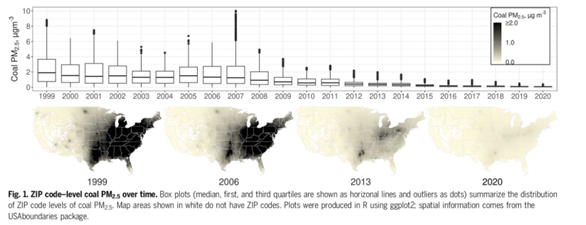The November 24, 2023, issue of Science magazine has a landmark paper on estimating mortality due to breathing micro particulate matter from coal burning power plants (Henneman, L., C. Choirat, I. Dedoussi, F. Dominici, J. Roberts, C. Zigler. 2023. Mortality risk from United States coal electricity generation. Science 6643: 941-946).
This paper is remarkable because the authors used medical records from Medicare to document 32.5 million deaths, allowing calculation of mortality due to particulate matter. They broke this down by zip code and also by year. At locations where there is no coal-fired power plant, they were able to calculate a background rate of mortality due to other sources of micro particulate matter (natural sources, transportation emissions, etc.). This allowed them to estimate the excess mortality due to proximity to power plants. The study is especially interesting for us because the two worst polluters in the entire mid-Atlantic region are in our area, the Keystone plant west of Indiana, PA, and the Homer City plant south of Indiana, PA.

First the good news. The air is much cleaner than it used to be. Regulations aimed at cleaning up the air have been effective on a continental scale. Atmospheric load of micro particulate matter declined by 97%, from 2.34 µm-3 (range, 0.01 to 8.80) in 1999 to 0.07 µm-3 (range, 0.00 to 0.39) in 2020 (Figure 1). The figure shows that the entire eastern half of the U.S. had high rates of coal-associated particulate matter in 1999 (black regions), while only certain major hubs continued to have high rates in 2013, and by 2020 the entire nation is very much cleaner (cream color).

Fig 2. Annual deaths attributable to individual coal-fired power plants: Keystone (light green) and Homer City (dark green.) Stars show when scrubbers were installed, Keystone (light green) and Homer City (black.)
The installation of scrubbers has been very effective in cutting risk due to micro particulate matter (Figure 2). Keystone showed a very rapid decline in associated mortality after installation of scrubbers in 2009 and 2010, with deaths dropping from 640 to about 80 per year. Homer City, Pennsylvania’s largest power plant, installed scrubbers in 2001 and 2014, after which deaths decreased similarly.
On the other hand, it appears that earlier calculations of mortality due to micro particulate matter from coal-fired power plants were underestimates. This may be due to the fact that coal-associated pollutants (particularly SO2) are more toxic than other micro particles, but discriminating the actual cause is not possible with these data. The final results from this study indicate that nationwide about 460,000 deaths since 1999 are attributed to this type of air pollution, mostly before 2007. The authors write “Annual excess deaths attributable to coal PM2.5 [micro particulate matter] were highest between 1999 and 2007, averaging more than 43,000 deaths per year for a total of 390,000 deaths. After 2007, annual excess deaths declined substantially, reaching 1,600 in 2020.” They conclude “The predicted excess mortality from coal power plant emissions in 2020 was just 3% of the predicted excess mortality in 1999.” Locally, Keystone and Homer City were contributing about 1,200 deaths annually in 1999, although now that number is much lower (see Fig 2). Today, Homer City is being decommissioned, and Keystone is scheduled to close by 2028.






